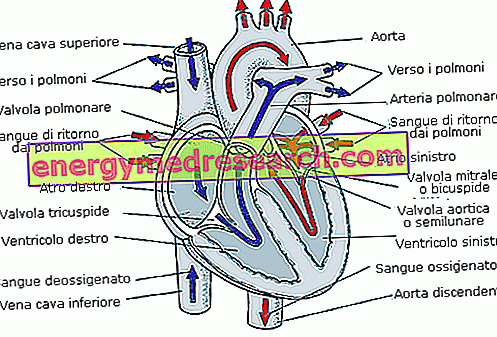See also: Correct breathing in Body Building
INTRODUCTION
The arterial blood from the heart, after passing through the tissue capillaries, drains into the venules, which collect in progressively larger caliber veins until they flow into the inferior vena cava (blood from the lower part of the body) or into the superior vena cava (blood from the head and upper limbs).
The blood coming from the two hollow veins enters the right atrium of the heart, from here it passes to the right ventricle which with its contraction pushes it into the pulmonary circle where it releases carbon dioxide and enriches itself with oxygen.
The blood returns to the heart via the pulmonary veins and is again circulated thanks to the contraction of the left ventricle.
VENOUS RETURN
The veins have inside them unidirectional valves that allow the blood to flow towards a single direction, the heart. The venous return is also facilitated by the dynamic action of the muscles. The role of muscle fiber contraction in facilitating venous return to the heart is so important that its defect can lead to fainting due to cerebral hypoxia.
Let us now focus on figure B. In this image the subject holds his breath and the glottis is kept closed voluntarily. Following the high muscular contraction that occurs at the level of the upper limbs and the increased intrathoracic pressure, there is an occlusion of the system of the hollow veins that bring blood back to the heart. An obstructed venous return to the heart muscle necessarily implies a reduced volume of systolic ejection (since the amount of blood leaving the heart is related to the amount of blood entering).

The reduced supply of blood and oxygen to the tissues leads to phenomena of cerebral distress that result in dizziness, in the vision of black spots, even to fainting.
The high intrathoracic pressure that is created also causes a pressure work of the heart that is forced to contract against very high resistance. As a result the systolic blood pressure (maximum pressure) increases sharply until it reaches values of 300 mmHg against the normal 120 mmHg.

This phenomenon is potentially dangerous especially in those who are at high risk of cardiovascular diseases. For these people, power activities and weight training exercises are not recommended and the practice of exercises with a high aerobic component should be encouraged.
A similar argument for all those people suffering from varicose veins, the increased pressure inside the veins themselves can in fact cause the valves to break, further aggravating the situation.
PLEASE NOTE: In particular exercises where the stresses to the spine are considerable (deadlift, squat and rowed chest flexed) it is good to hold the breath in the first part of the active or concentric phase. In fact, the action of holding the breath actually has a physiological function, namely that of contracting the muscles of the abdominal press in order to protect the vertebrae from the burden on them.



